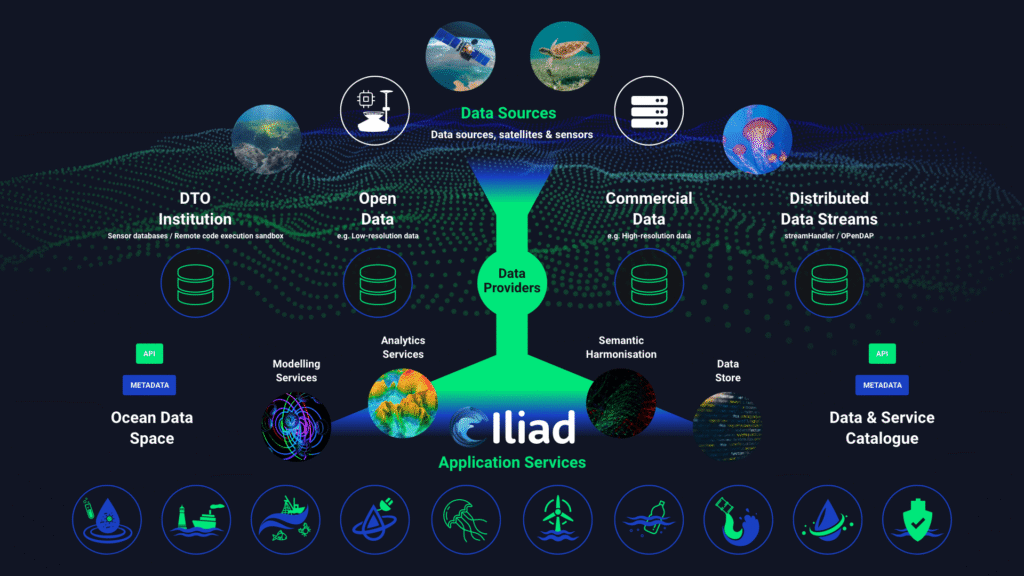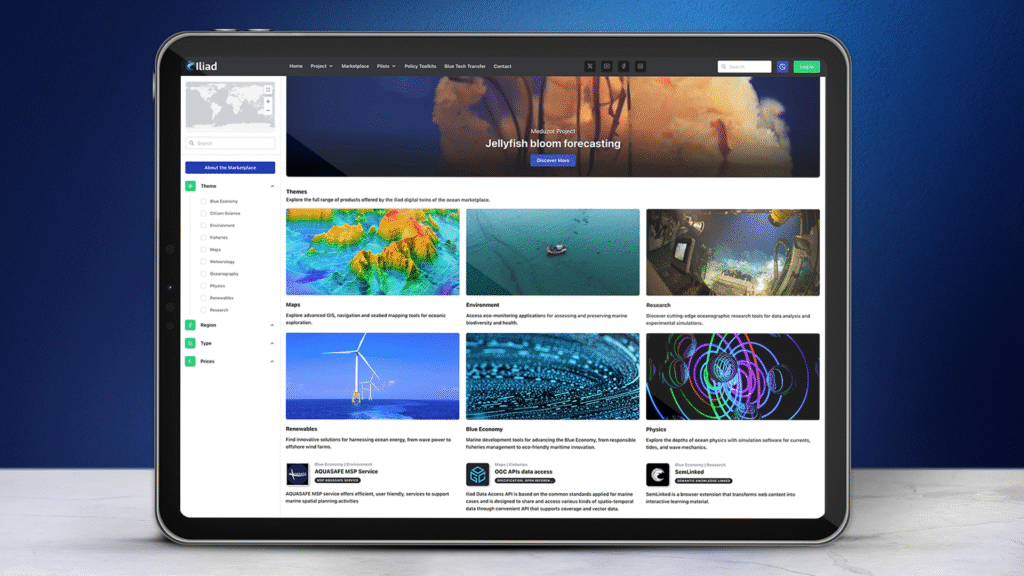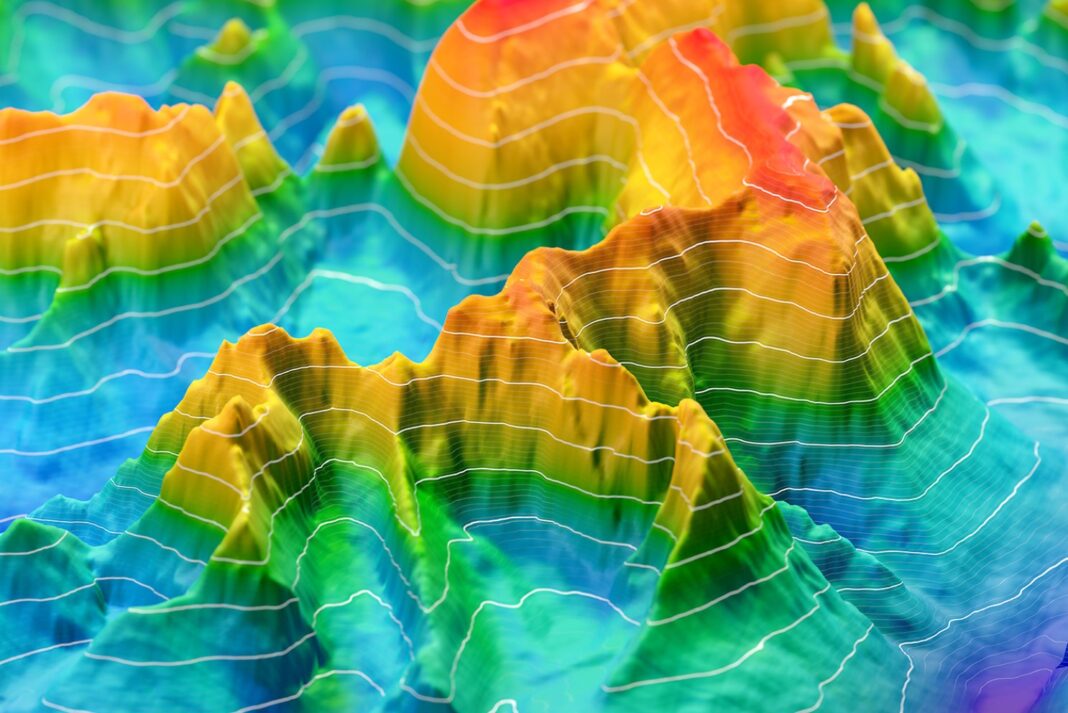Connecting physical and digital worlds with endless possibilities
In recent years, our oceans have become both a focus of global concern and an unprecedented technological frontier. Climate change, overexploitation of marine resources, and intensified coastal urbanization are problems that have created an increased need for integrated, real-time, and science-based ocean management tools. So, let’s talk about ILIAD, the Integrated Digital Framework for Comprehensive Maritime Data and Information Services. This ambitious European project aims to create a complete Digital Twin of the Ocean (DTO).
This next-generation digital infrastructure is designed to offer a dynamic and data-rich representation of marine environments. It supports an informed decision-making system, sustainable development, and innovation throughout the Blue Economy. With ILIAD, Europe takes a decisive step toward ocean intelligence: it combines satellite observations, sensors in situ, numerical models, artificial intelligence, and citizen science projects into a coherent and interoperable system. By delivering easy access to different types of data, simulations and applications through a flexible and modular architecture, ILIAD empowers stakeholders, including port authorities, offshore energy operators, marine biologists, public institutions, and coastal communities.

An ecosystem to monitor and predict oceanic processes
The core mission of ILIAD is to create a federated and extensible DTO ecosystem.
How does it appear? The setup functions as a simulation environment based on a comprehensive multi-variable, multi-dimensional description of the ocean. It spans from estuaries to the coast and extends to the open ocean, covering everything from the surface to the seabed. This configuration allows for a digital exploration of ocean physics and biodiversity, accommodating various scenarios over time and space. It aims to provide an integrated, timely, and consistent description of the ocean that includes at least the areas of physics, biogeochemistry, geology, and human activities. This system enables users to monitor and predict oceanic processes by integrating a big variety of data, varying from real-time sensors to historical datasets, within a scalable computational framework.
At its core is an interoperability architecture based on open standards and APIs, enabling the deployment of environmental models, geospatial analytics, and marine services across high-performance computing (HPC) and cloud functions. Coordinated by Netcompany-Intrasoft, a leading IT and consultancy company based in Belgium, ILIAD unites a strong international consortium. The project includes 56 partners from 18 countries, comprising research institutions, small and medium-sized enterprises (SMEs), government agencies, and marine data infrastructures.This collaborative structure ensures both scientific excellence and a strong connection to real-world operational needs.
ILIAD is funded under the Horizon 2020 programme, within the “Food security, sustainable agriculture and forestry, marine, maritime and in-land water research and the bioeconomy” challenge. The project has received an overall EU contribution of €18.96 million. On 1 February 2022, ILIAD was set up to run for three and a half years, concluding on 31 July 2025. Horizon 2020’s support places ILIAD within a broader strategic framework. The project aligns with the EU Green Deal, the UN Decade of Ocean Science, and the Destination Earth (DestinE) initiatives, reinforcing Europe’s commitment and dedication to environmental sustainability and digital transformation.
A marketplace for value-added services
One of ILIAD’s key innovations is its Marketplace, designed as a digital junction focused on the ocean. Here, users can discover and share data products, applications, services, and plugins, similar to an “App Store” for ocean-related tools. Whether it’s a model for predicting and indicating the presence of algal blooms (or also a dashboard for sustainable fisheries), the Marketplace serves as a springboard for value-added services and data-driven innovation.

The Iliad Marketplace is designed with a robust set of features to ensure its utility and accessibility for a diverse user base, encompassing marine scientists, policymakers and industry professionals. Its interface is intuitive, allowing users with varying levels of technical expertise to find tools, services, and content that meet their needs. A rich catalogue includes simulation algorithms, oceanographic datasets, dashboards, educational resources, and models for diverse applications. Standardisation is a central pillar.
The Marketplace promotes the use of interoperable formats and tools, enabling seamless integration of different products within the ILIAD framework. Smart wizards help users publish and manage their contributions, making it easy for developers and institutions to upload models or services. Once listed, products are supported by advanced metrics that allow their creators to track usage and engagement, gaining insights into performance and impact. The Marketplace is also designed as a living ecosystem. It evolves through community-driven development, encouraging contributions from researchers and developers worldwide. Its secure and scalable infrastructure ensures reliability, while its openness means that new content and tools continuously enrich the platform, extending its reach and usability across sectors like aquaculture, logistics, biodiversity monitoring, and climate resilience.
Progress in data integration, modeling, and pilot applications
In January 2023, the ILIAD project made significant advancement in multiple fronts. A major attainment was the integration and harmonization of diverse marine data sources. These include different paths: bathymetric and meteorological datasets, biodiversity and fishing activity records, geological features, and even indicators related to maritime cultural heritage. To manage all of this variety, the consortium has developed a dedicated Ocean Information Model (OIM), which introduces a semantic framework based on a set of 15 ontologies and standardized vocabularies. This system ensures that data from heterogeneous sources can be discovered, shared, and interpreted consistently across different platforms and applications.
The technical infrastructure supporting ILIAD has significantly advanced. A robust and scalable software framework has been implemented to facilitate the remote performance and orchestration of oceanographic models and simulations. The design adheres to Open Geospatial Consortium (OGC) standards and supports containerization, facilitating deployment across both cloud environments and high-performance computing systems.
The project has also launched a broad portfolio of pilot initiatives, over twenty use cases totally, which serve as demonstrators for ILIAD’s capabilities. These pilots address a wide range of ecological, industrial, and engineering challenges, such as pollution monitoring in ports, marine spatial planning, aquaculture risk management, and digital modeling of ecosystem services. All pilots have been developed through agile cycles of design and testing, supported by mock-ups and iterative feedback from relevant stakeholders.
Finally, the project has begun applying the groundwork for long-term impact through technology transfer and innovation support. Reliable activities have helped identify business opportunities for SMEs and startups, with a focus on commercializing ILIAD-based services and data products. This work aims to provide the remainance of the project’s outcomes sustainable and relevant beyond its formal conclusion, positioning ILIAD as a catalyst for growth in the emerging digital Blue Economy.
Fostering learning and shared expertise: the ILIAD Academy
As part of its long-term impact strategy, ILIAD has launched the ILIAD Academy—a freely accessible digital learning platform designed to empower a wide range of users with the knowledge and tools needed to understand, develop, and apply Digital Twins of the Ocean. The Academy offers self-paced, expert-led courses that explore fundamental aspects of DTOs, including principles of data sharing such as FAIR, CARE, and TRUST, approaches to real-time modelling, interoperability standards, and the role of citizen science in ocean data ecosystems. Rather than functioning as a static library, the Academy is a growing and adaptive resource. It combines technical instruction with a focus on sustainability, encouraging learners to engage with real-world challenges through practical knowledge.
Participants are introduced to the process of building digital twins from the ground up, gaining insight into the complexity of setting up pilot sites, designing interoperable applications, and integrating public engagement strategies. Special attention is given to how society at large can both contribute to and benefit from the digital replication of marine environments. Alongside its structured courses, the Academy features an expanding archive of recorded webinars and expert-led sessions that offer in-depth exploration of topics ranging from data architecture to innovation strategy. A repository of documentation, technical guides, and software tools complements the educational offer, supporting learners in transferring knowledge into practice. Its open-access nature ensures that all participants—regardless of background—can build a solid understanding of digital ocean technologies. In doing so, the ILIAD Academy fosters a culture of continuous learning and shared expertise, enabling people not just to follow innovation, but to shape it.
Preparing for the fourth Digital Ocean Forum in Brussels
The work driven by ILIAD will culminate at the fourth Digital Ocean Forum on 27–28 November 2025 in Brussels. This gathering will provide a focused space for ocean scientists, developers, policymakers, and innovators to critically assess advancements and collaboratively define the next steps in building Europe’s Digital Twin Ocean. At its heart will be the latest developments of EDITO—the European DTO public infrastructure powered by EMODnet and the Copernicus Marine Service—offering live demonstrations and hands-on sessions that highlight its potential for rapid ocean assessments, scenario planning, and science-based decision-making.
As the project approaches its formal conclusion in July 2025, efforts are already underway to ensure that ILIAD’s legacy endures. A number of business-oriented initiatives have been launched to support technology transfer and the commercialisation of services developed within the project. SMEs and startups are being equipped with the tools and guidance needed to transform ILIAD-based innovations into viable products, while open-access platforms and transferable software components guarantee continuity and adaptability beyond the project’s lifespan. Through this approach, ILIAD is shaping tools that serve today’s needs while preparing the foundation for tomorrow’s Blue Economy.
References:
- Brönner, U., Sonnewald, M., & Visbeck, M. (2023). Digital twins of the ocean can foster a sustainable blue economy in a protected marine environment. International Hydrographic Review, (5/1).
- Egerer, M., Ristolainen, A., Piho, L., Vihman, L., & Kruusmaa, M. (2024). Hall effect sensor-based low-cost flow monitoring device: Design and validation. IEEE Sensors Journal, 24(5).
Maso, J., Brobia, A., Voidrot, M.-F., Zabala, A., & Serral, I. (2023). G-reqs, a new model proposal for capturing and managing in situ data requirements: First results in the context of the Group on Earth Observations. Remote Sensing, 15(6), 1589.


